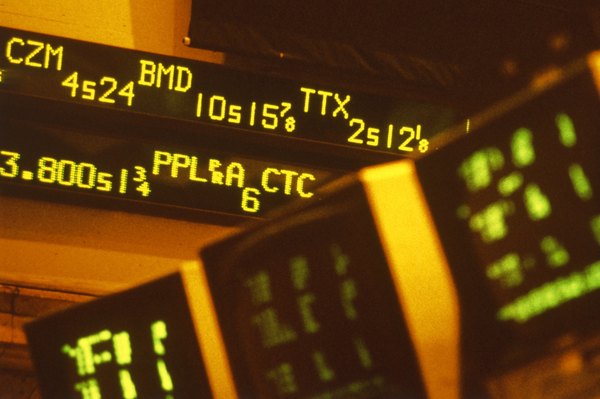How to Find Trending Stocks
Find trending stocks using historical data.
Jupiterimages/Photos.com/Getty Images
A stock or security rarely moves in a linear direction; instead it fluctuates up and down. An investor can mine stock market data and identify a movement or trend in an industry or a stock by studying its performance over a period of time. Many financial analysts produce lists of trending stocks or industries. But trends can come and go quickly, and there is no official list or method for identifying trending stocks. Simple research techniques can be used to find stock trends.
Tip
The term "trending" indicates upward or downward movement. Highly trending stocks typically hold an upward trend for a period of time longer than a day or week.
Using the Bottom-Up Method
Visit the website of a respected stock market or investment publication. These publications list stocks that are setting 52-week highs or lows. A high or low stock price could indicate an overall trend.
Select a stock from the list to view detailed data about it. Selecting a single stock to follow is referred to as a bottom-up method of finding trending stocks.
Select the option to view the stock's historical data. Historical data can be filtered by a time frame such as six months, one year or three years. The results typically are returned as a chart that shows a clear pattern of the rise and fall of the stock's price.
Note the movement of the stock's price. If the chart shows the price steadily climbing, this indicates the stock is trending up. If the chart shows movement up and down but overall the chart indicates downward movement, this stock's price is dropping and new highs are not occurring. This stock is trending downward.
Using the Top-Down Method
Pay for a stock research service, or use free stock research tools offered by online financial-services companies to identify trending securities using the research service's proprietary software. Stock research software allows the user to select or screen stock groups and industries on a variety of criteria. Some software selects and presents trending stocks to users according to its own formula or guiding principles.
View industry data according to the software's options. By selecting and viewing recent and historical data about a specific industry, the investor can identify companies, and therefore securities, that warrant further research.
View the top 10 performing industries or groups of industries and drill down into the list to discover stocks that are trending. Again, the software typically includes the option of viewing historical data and charts that would show the rise and fall of stock prices. Remember that just because a stock is part of an upward trending industry, that does not mean the stock itself is trending upward.
A Stock's Historical Trending Data
The availability of historical data depends on how long the stock has been traded. The longer the stock has been traded, the more data is available. For instance, a stock that's been available for only six months will show only six months of data. A stock that has traded for three years or longer will have trending data for three years or longer.
References
Resources
Tips
- The term "trending" indicates upward or downward movement. Highly trending stocks typically hold an upward trend for a period of time longer than a day or week.
- The availability of historical data depends on how long the stock has been traded. The longer the stock has been traded, the more data is available. For instance, a stock that's been available for only six months will show only six months of data. A stock that has traded for three years or longer will have trending data for three years or longer.
Writer Bio
Alex Burke holds a degree in environmental design and a Master of Arts in information management. She's worked as a licensed interior designer, artist, database administrator and nightclub manager. A perpetual student, Burke writes Web content on a variety of topics, including art, interior design, database design, culture, health and business.

